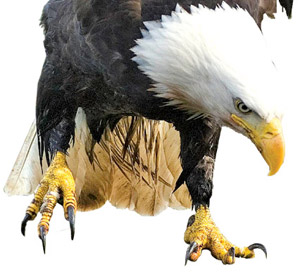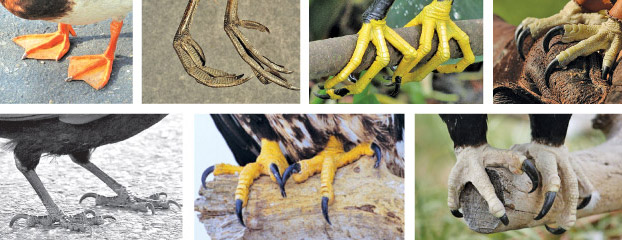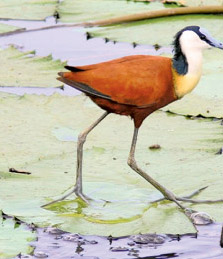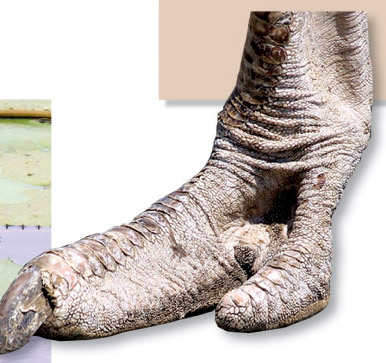Nature trail
Useful tools:
How birds use feet and talons
  Last
week we enlightened you about the various types of bird beaks and how
our feathered friends from the avian world make use of them as tools. As
promised, today we feature some interesting information about their feet
and talons which are also very useful tools for them, like their beaks. Last
week we enlightened you about the various types of bird beaks and how
our feathered friends from the avian world make use of them as tools. As
promised, today we feature some interesting information about their feet
and talons which are also very useful tools for them, like their beaks.
Just as much as a bird's beak aids us to learn about its eating
habits, a bird's feet and talons too reveal a lot about its habits.
All birds have feet so what's special about them, you may wonder.
Well, it's true that every bird has a pair of feet, but what's special
is the fact that they are not all alike, and also the way, each species
uses them as 'tools' to catch their prey and also to get about is
different. A bird's feet are such useful tools that certain species of
birds depend on them totally; they prefer to walk or swim instead of
fly!
Among the birds that depend on their feet more than their wings are
the emu, cassowary, kiwi rhea, ostrich (the world's largest bird) and
the kakapo (the world's only flightless parrot). Some of these birds,
such as the ostrich and its relatives the emu, rhea and cassowary, live
solely on land and have strong feet. They are all exceptional runners
and can out-pace the fastest hunters. They use their powerful feet to
deliver a vicious kick to enemies that get too close to them. When
cornered, a cassowary which is 1.7m tall would jump up and strike out
with its huge, blade-like claws.
Even though all birds have two feet, not all of them have four digits
or toes on them. The ostrich, for instance, has only two digits.
|

An osprey |
Its rear facing and inner toes have disappeared, resembling the feet
of an antelope. Perhaps, the fact that it has only two toes is why it is
considered the fastest animal or bird on two legs. It is said that this
huge, flightless bird can reach at least, 70km/h in short bursts which
is sufficient speed to outrun predators like hyenas and lions.
Most birds have three forward pointing toes and one facing backward
on each foot, which act like our fingers and thumb. Perching birds have
a special ligament which automatically locks their toes around the
perch, when they settle down on them to rest or sleep.
Are you aware that like we have nails on our fingers bird's also have
nails at the end of the toes (or four digits) on their feet? However,
these are not called nails' when it comes to birds. They are known as
claws. These claws are very prominent in birds of prey and are special.
They are referred to as talons. Let's find out what makes the feet of
birds of prey so special.
We know that claws are not unique to birds of prey because even cats,
dogs, squirrels, raccoons and even the world's timiest birds humming
birds have claws. Then, what's special about these talons or claws of
birds of prey? If you happen to examine an eagle's talons, you will
discover how strong and sharp they are. These talons are not only
sharper than a cat's claws, but also designed to carry its prey. An
eagle has four muscular toes on each foot which are powerful enough to
hang on to a large fish as it carries it through the air, and also
extremely sharp, hooked claws which can slice into the thick scales of a
fish or stab deep into the body of a rabbit's body to kill it as quickly
as possible. A swift kill prevents the eagle from sustaining injuries
from the dying animal's struggles.

All birds of prey, from the tiniest Elf owl and American Kestrel to
the largest, the eagle, have talons. An eagle's talons are sharp,
powerful and awesome in appearance and are among the largest and
strongest in the bird world. However, you may find it hard to believe
that they rank as second best when it comes to catching fish with them.
Guess which bird of prey comes first? The osprey. The reason an osprey's
talons are best has everything to do with the formation of its toes.
Both eagles and ospreys have three front toes and one back toe, but with
one difference; the ospreys have opposable front toes like our thumbs
which can rotate backward.
Now, let's find out how such an opposable toe has given the osprey
the edge over an eagle. According to experts who have researched into
this, when an eagle holds a fish, it has the front toes of both feet
that is six toes, on one side and just two toes on the other.
It's not a balanced grip on the prey. So, when a fish that is
captured by an eagle thrashes its body back and forth in its struggle
against being caught, especially from the front, with no toes at the
back pushing the opposite way, it has a chance to jerk itself free. The
osprey on the other hand catches its prey with two toes from both feet
on each side of the fish. This is a well balanced grip. The prey finds
it difficult to jerk free from such a good grip. However, an eagle's
talons are very powerful and strong, allowing it to catch prey on the
ground or in the water, 'on the wing' or while still in flight. Their
talons are strong enough to carry prey which weigh more than the eagle
itself.
|

Lilly trotter |
As we said before, not all birds have feet with toes and claws or
talons. Birds that swim have feet which are different to birds that fly.
Webs between the toes are found in ducks, swans, seagulls gees and other
birds that swim. A duck such as the mallard has webbing in between each
toe.
|

An ostrich’s foot |
The foot acts as an efficient paddle. And in the same way that boats
have propellers at the stern, these birds have their legs at the rear of
their bodies. The position of their feet are what make ducks walk in an
ungainly manner when out of water.
Wading birds generally have long legs and toes. If you have seen a
bird called the lilly trotter, you may wonder if it's running across the
water. No, it is running over the floating leaves of aquatic vegetation
such as lilly pads without sinking into the water. It is able to do so
because of its thin, widely spread toes. The toes spaced in this manner
spread its body weight over a large area.
All birds have feet that are used in some way for their survival.
Most of the time, they use their feet to walk on, but as some birds have
talons they find it hard to walk on them. A good example of this is the
osprey. As its talons are curved or bent, it is hard for the osprey to
walk on the ground.
Even though birds of prey have sharp claws snake hunting birds have
shorter toes to prevent the snake from wiggling out of its grip. Owls
also hunt but they do not use their talons to tear their prey, only to
puncture them. So, they have weak feet but, sharper talons. However, the
bottom of an owl's foot is bumby so that prey can be gripped better.
Find out more of the various ways birds use their feet for survival.
Pix and facts: Internet
**************
Fast facts on animal feet
* Flat footed animals walk on the palms and bones below the ankle and
include runners, climbers and burrowers.
* Toe runners run on the bones of their toes and all birds are toe
runners.
* Nail runners move on the tips of toes and hooves (thickened nails).
* The talons of a baby eagle are very short when compared to an adult
eagle.
* Most raptors use their feet to capture, hold and kill their prey so
their feet and talons have to be very strong.
* The muscles that make it possible for a bird to perch and grab its
prey are at the top of the leg.
* Raptors have the ability to lock their feet around a branch, relax
their muscles and still stay firmly in place without falling.
* An owl is the only raptor with the ability to move its outer toe to
the back when perched on a tree.
* A bird can put about 1400 pounds of pressure on its prey using its
talons when a human can only put about 400.
* Talons can pierce right through the body of a rodent.
* Robins use their feet to walk around and find worms in the ground.
**************
Feet
Description Function
* Long muscular legs running
* Long skinny legs wading
* Short legs with blunt claws scratching, ground walking
* Three toes in front, one behind perching
* Webbed swimming
* Large hook-like claws (talons) grasping prey
* Tiny short legs hovering
* Two toes in front, two behind climbing |

